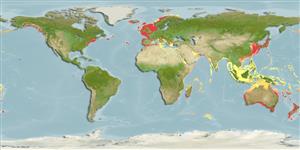Common names from other countries
Classification / Names / Names
Nomes comuns | Sinônimos | Catalog of Fishes (gen., sp.) | ITIS | CoL | WoRMS
Environment: milieu / climate zone / depth range / distribution range
Ecologia
Pelágico(a,os,as); intervalo de profundidade 0 - 250 m (Ref. 1134). Subtropical; 7°C - 30°C (Ref. 1134)
Atlantic, the Mediterranean and Indo-Pacific. Tropical to temperate.
Length at first maturity / Tamanho / Peso / Idade
Maturity: Lm ? range ? - ? cm Max length : 60.0 cm COLD macho/indeterminado; (Ref. 1610)
Minimum depth from Ref. 116065.
Life cycle and mating behavior
Maturidade | Reprodução | Desova | Ovos | Fecundidade | Larvas
Members of the order Pyrosomatida includes clonal and sexual phases in its life cycle. Life cycle: Eggs develop into lecithotrophic oozooid (cyathozooid) which undergo budding to form four blastozooids. The oozoid degenerates and the colony is formed from the blastozooids.
Kott, P. 2005. (Ref. 1134)
Status na Lista Vermelha da IUCN (Ref. 130435: Version 2024-1)
Status no CITES (Ref. 108899)
Not Evaluated
Not Evaluated
Uso pelos humanos
| FishSource |
Ferramentas
Mais informação
Idade/Tamanho
Crescimento
Comprimento-peso
Comprimento-comprimento
Morfologia
Larvas
Abundância
Fontes da internet
Estimates based on models
Vulnerabilidade
Moderate vulnerability (44 of 100).
Categoria de preço
Unknown.
